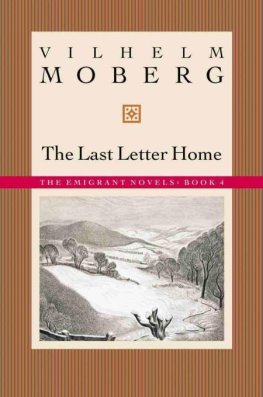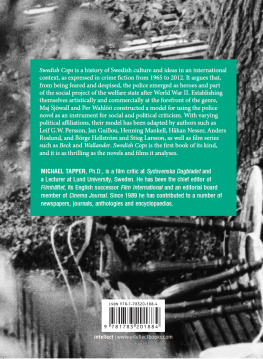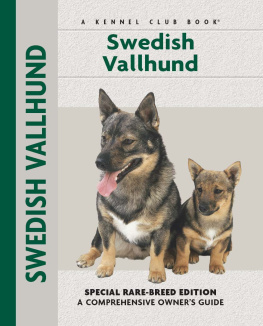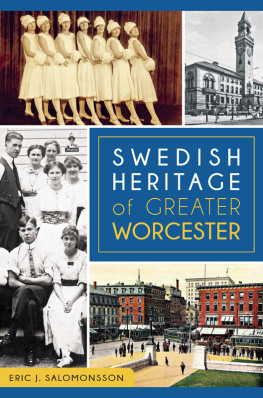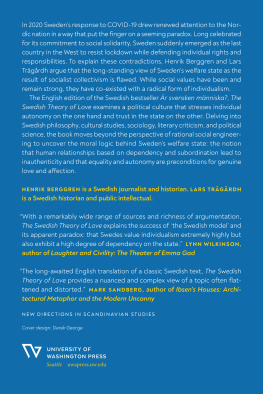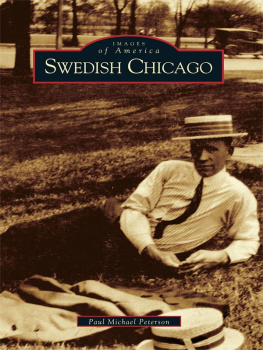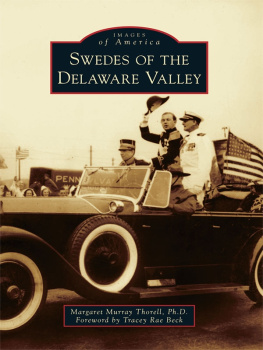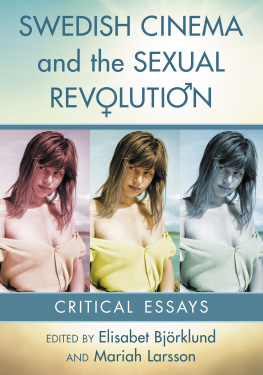Welcome Home
Mr Swanson
Swedish Emigrants and Swedishness on Film
Ann-Kristin Wallengren
Translated by
Charlotte Merton

NORDIC ACADEMIC PRESS
This book presents the results of the research project Film and the Swedish Welfare State, funded by the Bank of Sweden Tercentenary Foundation. It has been translated and published with the support of the Foundation Olle Engkvist Building Contractor, the Sven and Dagmar Saln Foundation, and King Gustaf VI Adolfs Foundation for Swedish Culture.
Copying or other kinds of reproduction of this work
requires specific permission by the publisher.
Nordic Academic Press
P. O. Box 1206
221 05 Lund
Sweden
www.nordicacademicpress.com
Nordic Academic Press and Ann-Kristin Wallengren 2014
Swedish original, 2013: Vlkommen hem Mr Swanson
Svenska emigranter och svenskhet p film.
Translation: Charlotte Merton
Cover design: Per Idborg
Cover photos: Swedish Film Institute Archive
Tryckt utgva ISBN 978-91-87675-11-9
E-bok ISBN 978-91-87675-13-3
CHAPTER 1
The movies and emigration to America
An introduction
Perhaps the most significant event in the history of modern Sweden. This is how the historian Lars Ljungmark characterizes Swedish emigration to the US in the period 18601923. By far the greatest number left for the US during the years of mass emigration from 1880 to 1914, an exodus which was so troubling for Sweden that the government not only commissioned a detailed inquiry, but went so far as to found an association whose purpose was to oppose emigration. In the last wave of emigration, people fled the Depression in Sweden during the 1920s.
Is it true that the typical emigrant was a farmer attracted by new land in Minnesota? There were indeed a great many farmers among those who left Sweden, but between 1850 and 1920 fully one-quarter of emigrants were town-dwellers. Many Swedes distinguished themselves in the construction industry in particular.
The waves of emigration did indeed include many people from the southern province of Smland, especially from what were then the counties of Jnkping and Kalmar. In many cases emigration was motivated by religion; their home area was characterised by fervent revivalist and Free Church movements. However, many emigrants also came from other southern provinces (Skne and Blekinge), central Sweden (Bohusln, stergtland, the city of Gothenburg, and, in some periods, lvsborg) and various regions in the north of Sweden. Most often, emigrants were not entire families, but single men or women, especially during the later waves of emigration. At times, single women between 15 and 29 years old were the most common emigrants, and often found employment as maids or in other forms of domestic service.
In this book I analyse how emigration, emigrants, and returning Swedish Americans have been construed and represented in Swedish film. The focus is on motion pictures from the period 191050, and to some extent subsequent developments until around 1980. The picture presented by Swedish movies is an ambivalent one. Emigrants could be seen as traitors to the nation, representing what were perceived as the negative aspects of Americaor, as doughty settlers, seeking a new life in a land of opportunity, and returning to Sweden with a modernizing spirit and democratic ideals. Which of these depictions is used is often linked to how the Swedish national identity is valued.
Swedish immigrants to the US created a cultural identity and community through activities such as running their own newspapers, publishing literature from their own publishing houses, and staging plays. Swedish Americans also went to the cinema, and Swedish films were imported for showing to Swedish American groups, both privately and through distribution companies. In this book I will analyse the films chosen by the Swedish immigrants for distribution, how and where these films were shown, and how they were reviewed in the press. I will then go on to discuss those aspects of the old country that were chosen for reproductionthose that Swedish Americans wished to remember and identify with, and which became a part of a transnational Swedish American identity. I consider notions of Swedishness and representations of America and Sweden, and how, in the light of those representations, those who emigrated to America were portrayed in film, as well as how Swedish Americans regarded their Swedishness and how they construed their transnational cultural identity with the help of the movies. Finally, I take a closer look at how Swedish American women have been depicted in American film, which, given how emigrant women were construed in Swedish movies, makes for an interesting comparison. From this perspective, issues such as cross-dressing, national affiliation, and the depiction of role models are important to study as part of the two film cultures. When it comes to the Swedish context, there has been very little prior research on film, media, and emigration to the US.
There is more extensive research into the importance of theatre, literature, and the press in the construction of a new migrant identity or in creating a collective memory of the old country. In his dissertation on the image of the US in Swedish prose fiction, Lars Wendelius focuses on the ways in which Swedish Americans were representeda body of research which I have used extensively. I will return to this research later in the book.
There is now a considerable amount of research into American immigrant groups and their media, but it rarely has historical ambitions and is often concerned with the production of film and other media in exile. Also, there is not exactly an abundance of research into how emigration and emigrants have been construed and represented within national film traditions. One example is Stephanie Rainss recent The Irish-American in Popular Culture, 19452000, which looks at the representation of Irish-American women and men in American film, and at the ways that representations of the Irish family in American film influence memories of the old country. Rains writes about popular culture in general, but gives most weight to visual representations.
Even though a historical perspective is not particularly common in studies of emigration as it appears in film and other media, there are many similarities between the historical situation and how todays exile groups use film and media to maintain various forms of contact with their homelands. Here the film and media scholar Hamid Naficy has been very influential, and although mainly concerned with how Iranians in the US today use Iranian television, there are surprising parallels with how Swedish Americans used and described feature films and documentary shorts made by Swedish filmmakers between 1920 and about 1950. The satellite dishes which are to be found on nearly every balcony in the areas of Swedish cities with a high proportion of immigrant residents are not a new phenomenonthe immigrant Swedes in the US maintained contact with the home country and built their new identities using the same cultural practices.
Swedish emigration to the US was a national trauma, which was taken up and addressed in the cultural sphere, including in movies. Film, an art form which is at once popular, commercial, and artistic, has a rare ability to capture general attitudes, opinions, and ideas. Claude Lvi-Strauss is one of those who have shown how narratives can attempt, in a symbolic sense, to solve or deliberate upon social or political problems, for example, issues based upon ethnicity, class, or gender. These issues are construed through such narratives as unavoidable or natural. Analysis can elucidate these practices, and film, which is both a system of representation and a narrative structure, richly rewards an ideological analysis.
Next page

